Home > Rare endocrine disorders > Sogroya®

Sogroya® Formulary Kit
Sogroya® (somapacitan-beco) injection is indicated for pediatric patients aged 2.5 years and older with growth failure due to inadequate secretion of endogenous growth hormone (GH), and for replacement of endogenous GH in adults with growth hormone deficiency (GHD).
We didn't find any resources that match your selection.
Please adjust your filter(s) and try again.
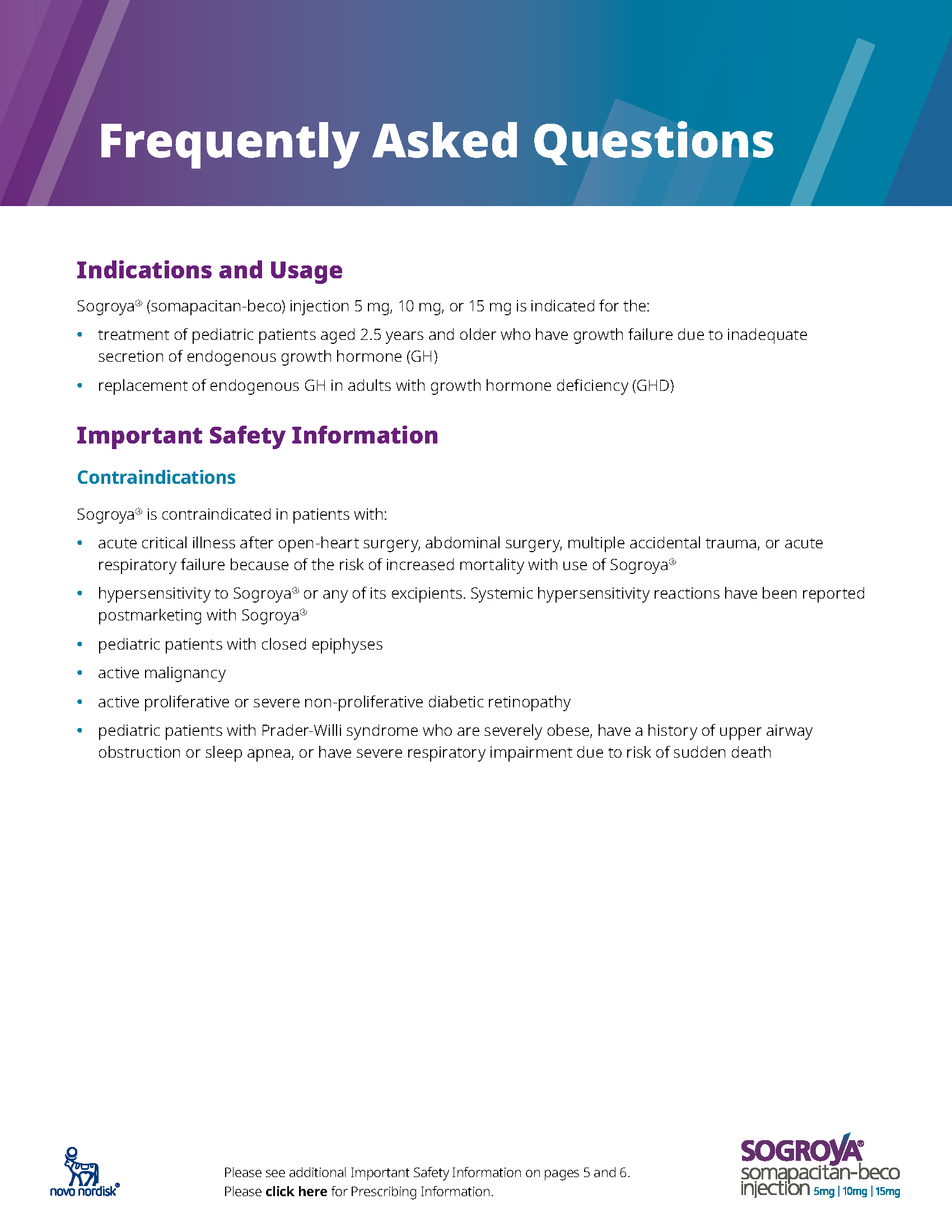
Sogroya® Frequently Asked Questions
Summary of important information about Sogroya® and FAQs about the use of Sogroya® for the treatment of growth hormone deficiency (GHD).
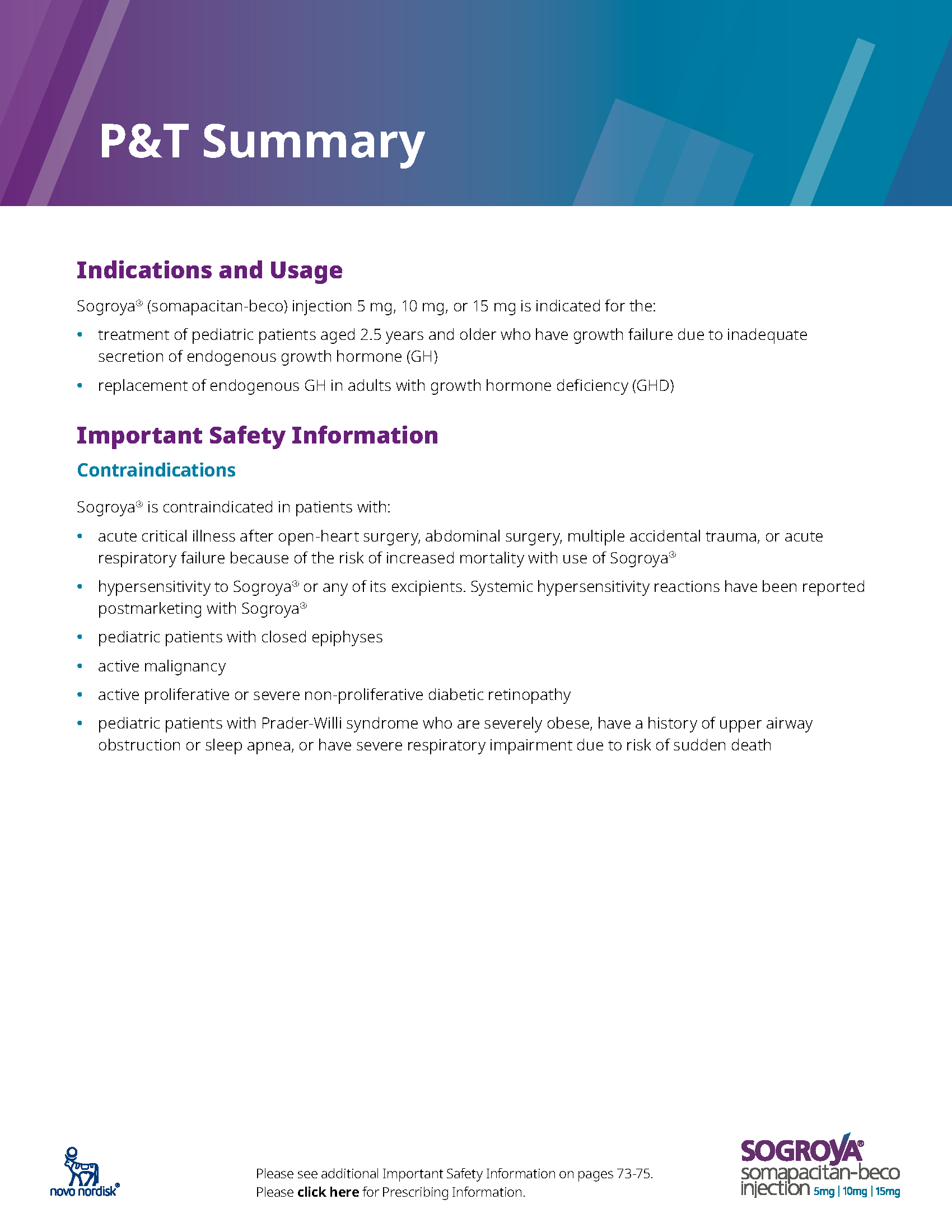
Sogroya® P&T Summary
Overview of growth hormone deficiency and treatment options, introduction to Sogroya®, review of Prescribing Information, distribution, and administration information.
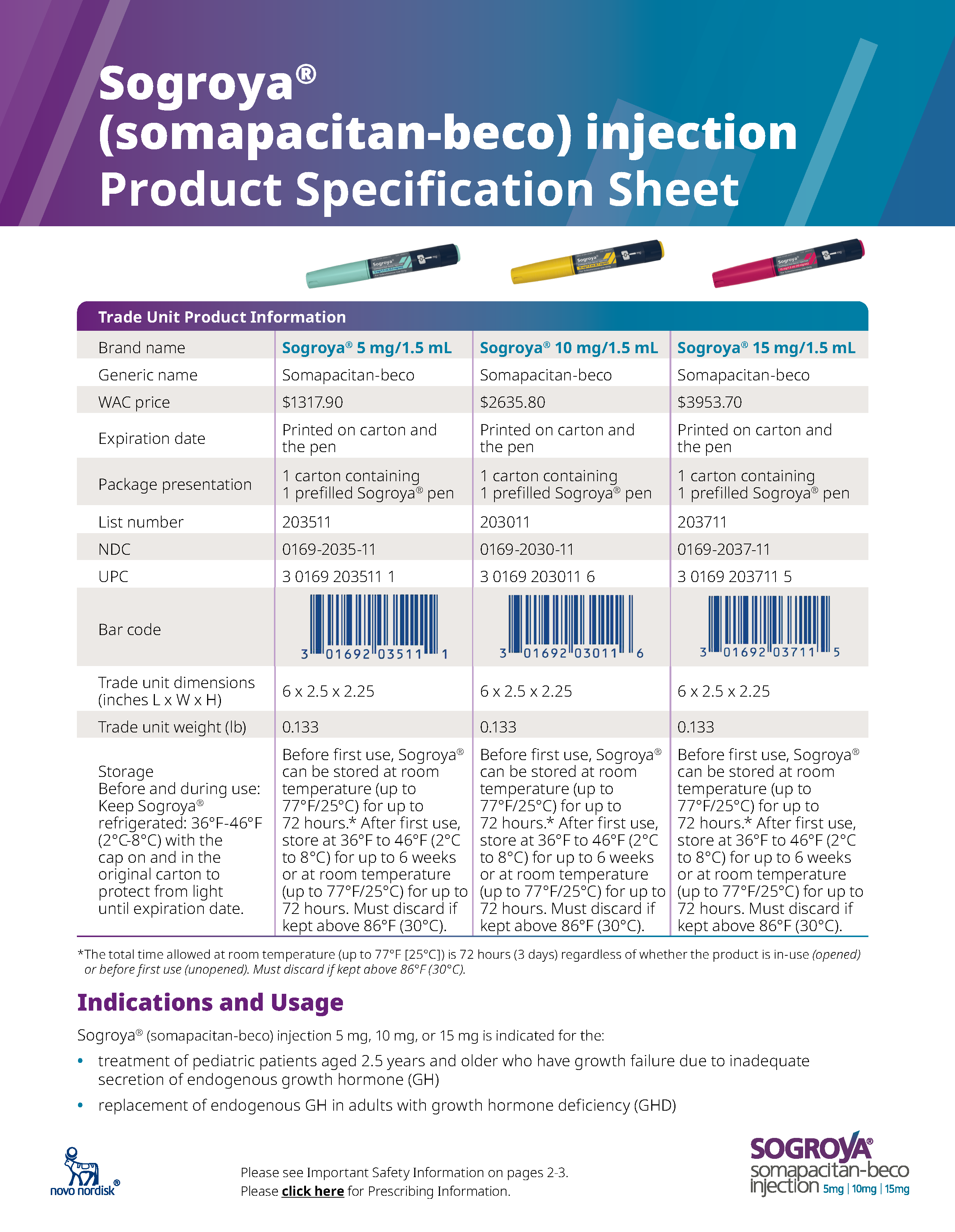
Sogroya® Product Specification Sheet
Trade unit product specification information, including wholesale acquisition cost and National Drug Code numbers, packaging information, and how Sogroya® is supplied.
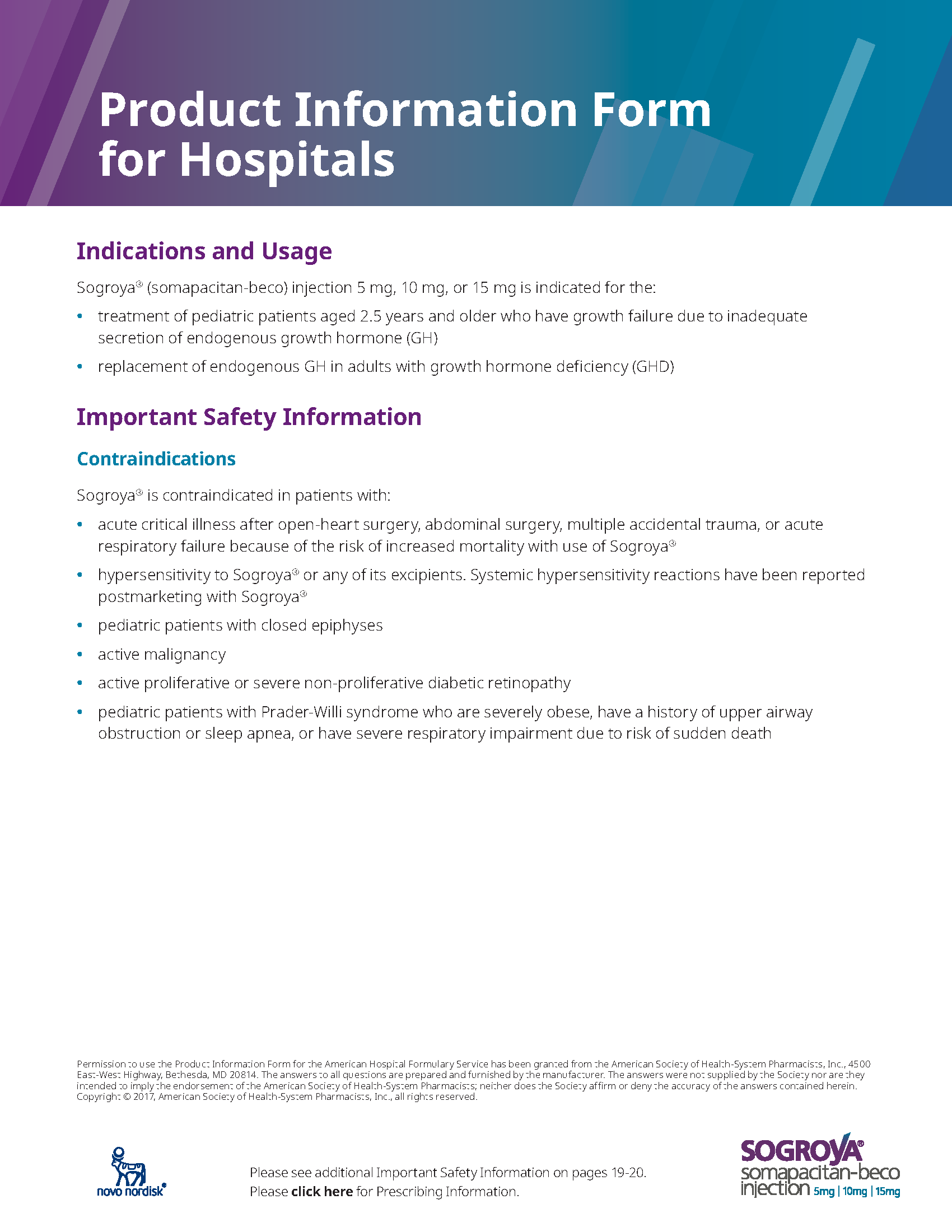
Sogroya® Product Information Form for Hospitals
Similar to Prescribing Information. American Hospital Formulary Service (AHFS) format. With AHFS classification number and full Important Safety Information (ISI).
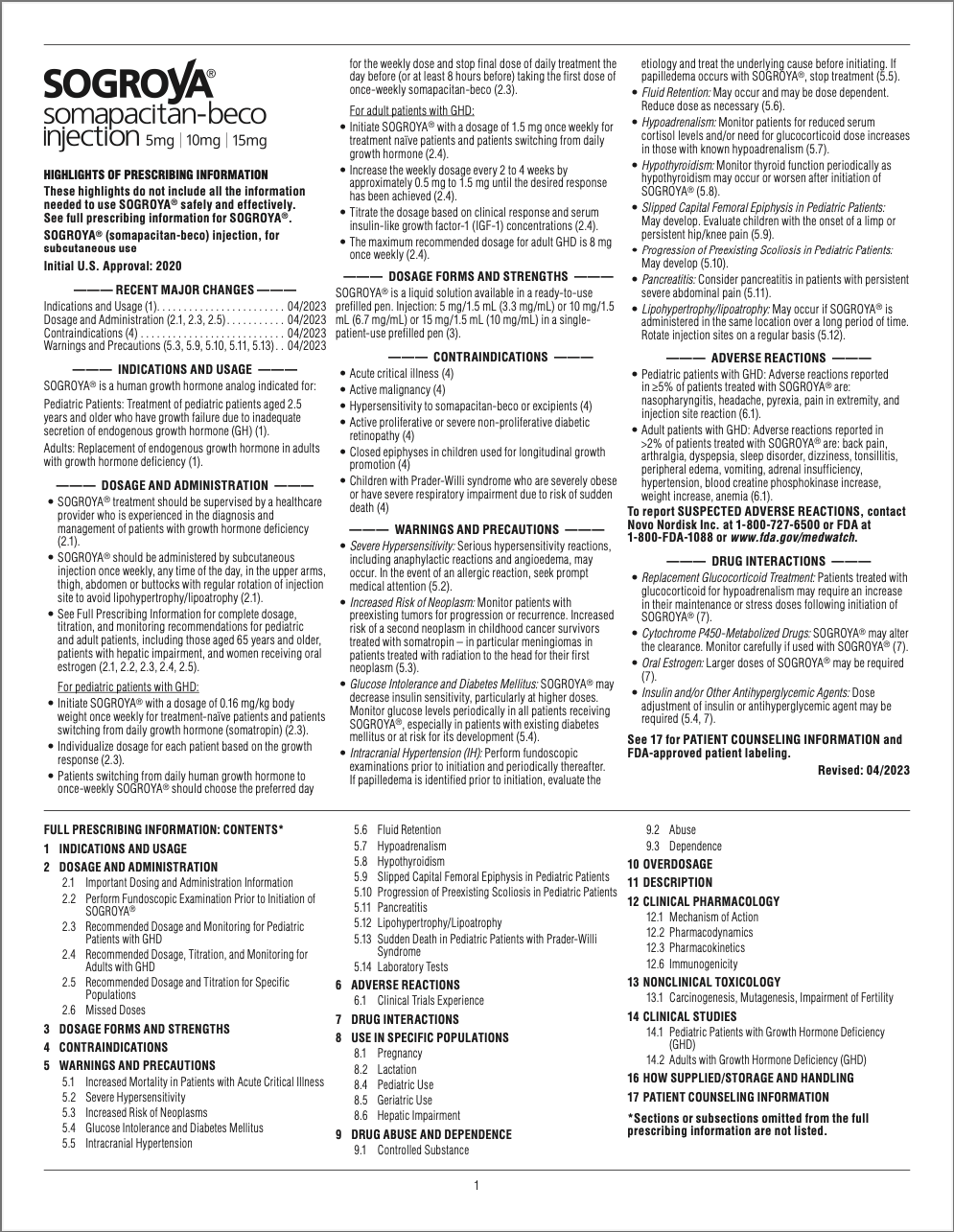
Sogroya® Full Prescribing Information
Full Prescribing Information for Sogroya®, patient product information, and instructions on how to use the Sogroya® pen.
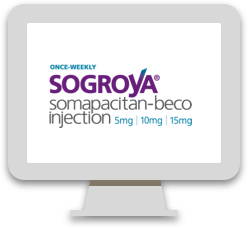
Sogroya® Professional Website
This website provides information about Sogroya®, including efficacy, pharmacology, and dosing.
Important Safety Information for Sogroya®
Contraindications
Sogroya® is contraindicated in patients with:
- acute critical illness after open-heart surgery, abdominal surgery, multiple accidental trauma, or acute respiratory failure because of the risk of increased mortality with use of Sogroya®
- hypersensitivity to Sogroya® or any of its excipients. Systemic hypersensitivity reactions have been reported postmarketing with somatropin
- pediatric patients with closed epiphyses
- active malignancy
- active proliferative or severe non-proliferative diabetic retinopathy
- pediatric patients with Prader-Willi syndrome who are severely obese, have a history of upper airway obstruction or sleep apnea, or have severe respiratory impairment due to risk of sudden death
Warnings & Precautions
- Increased Mortality in Patients with Acute Critical Illness: Increased mortality has been reported after treatment with somatropin in patients with acute critical illness due to complications following open-heart surgery, abdominal surgery, multiple accidental trauma, and in patients with acute respiratory failure
- Severe Hypersensitivity: Serious systemic hypersensitivity reactions including anaphylactic reactions and angioedema have been reported postmarketing with use of somatropin. Inform patients and/or caregivers that such reactions are possible, and that prompt medical attention should be sought if an allergic reaction occurs
- Increased Risk of Neoplasms: There is an increased risk of malignancy progression with somatropin in patients with active malignancy. Any preexisting malignancy should be inactive, and its treatment complete prior to instituting Sogroya®. In childhood cancer survivors treated with radiation to the brain/head for their first neoplasm who developed subsequent GHD and were treated with somatropin, an increased risk of a second neoplasm has been reported. Monitor patients with a history of GHD secondary to an intracranial neoplasm for progression or recurrence of the tumor. Children with certain rare genetic causes of short stature have an increased risk of developing malignancies and should be carefully monitored for development of neoplasms. Monitor patients for increased growth or potential malignant changes of preexisting nevi. Advise patients/caregivers to report changes in the appearance of preexisting nevi
- Glucose Intolerance and Diabetes Mellitus: Treatment with somatropin may decrease insulin sensitivity, particularly at higher doses. New onset type 2 diabetes has been reported. Monitor glucose levels in all patients, especially in those with existing diabetes mellitus or with risk factors for diabetes mellitus, such as obesity, Turner syndrome or a family history of diabetes mellitus. The doses of antidiabetic agents may require adjustment when Sogroya® is initiated
- Intracranial Hypertension: Has been reported usually within 8 weeks of treatment initiation. Perform fundoscopic examination prior to initiation of treatment and periodically thereafter. If papilledema is identified, evaluate the etiology, and treat the underlying cause before initiating Sogroya®. If papilledema is observed, stop treatment. If intracranial hypertension is confirmed, Sogroya® can be restarted at a lower dose after intracranial hypertension signs and symptoms have resolved
- Fluid retention: May occur during Sogroya® therapy. Clinical manifestations of fluid retention (e.g. edema and nerve compression syndromes including carpal tunnel syndrome/paresthesia) are usually transient and dose dependent
- Hypoadrenalism: Patients receiving somatropin therapy who have or are at risk for corticotropin deficiency may be at risk for reduced serum cortisol levels and/or unmasking of central (secondary) hypoadrenalism. Patients treated with glucocorticoid replacement for previously diagnosed hypoadrenalism may require an increase in their maintenance or stress doses following initiation of Sogroya®. Monitor patients with known hypoadrenalism for reduced serum cortisol levels and/or need for glucocorticoid dose increases
- Hypothyroidism: Undiagnosed/untreated hypothyroidism may prevent an optimal response to Sogroya®. Monitor thyroid function periodically as hypothyroidism may occur or worsen after initiation of Sogroya®
- Slipped Capital Femoral Epiphysis in Pediatric Patients: Slipped capital femoral epiphysis may occur more frequently in patients undergoing rapid growth. Evaluate pediatric patients with the onset of a limp or complaints of persistent hip or knee pain
- Progression of Preexisting Scoliosis in Pediatric Patients: Monitor patients with a history of scoliosis for disease progression
- Pancreatitis: Cases of pancreatitis have been reported in patients receiving somatropin. The risk may be greater in pediatric patients compared to adults. Consider pancreatitis in patients with persistent severe abdominal pain
- Lipohypertrophy/Lipoatrophy: May occur if Sogroya® is administered at the same site over a long period of time. Rotate injection sites to reduce this risk
- Sudden death in Pediatric Patients with Prader-Willi Syndrome: There have been reports of fatalities after initiating therapy with somatropin in pediatric patients with Prader-Willi syndrome who had one or more of the following risk factors: severe obesity, history of upper airway obstruction or sleep apnea, or unidentified respiratory infection. Male patients with one or more of these factors may be at greater risk than females. Sogroya® is not indicated for the treatment of pediatric patients who have growth failure due to genetically confirmed Prader-Willi syndrome
- Laboratory Tests: Serum levels of inorganic phosphorus and alkaline phosphatase may increase after Sogroya® therapy. Serum levels of parathyroid hormone may increase with somatropin treatment
Adverse Reactions
- Pediatric patients with GHD: Adverse reactions reported in ≥5% of patients are nasopharyngitis, headache, pyrexia, pain in extremity, and injection site reaction
- Adult patients with GHD: Adverse reactions reported in >2% of patients are back pain, arthralgia, dyspepsia, sleep disorder, dizziness, tonsillitis, peripheral edema, vomiting, adrenal insufficiency, hypertension, blood creatine phosphokinase increase, weight increase, and anemia
Drug Interactions
- Glucocorticoids: Patients treated with glucocorticoid for hypoadrenalism may require an increase in their maintenance or stress doses following initiation of Sogroya®
- Cytochrome P450-Metabolized Drugs: Sogroya® may alter the clearance. Monitor carefully if used with Sogroya®
- Oral Estrogen: Patients receiving oral estrogen replacement may require higher Sogroya® dosages
- Insulin and/or Other Antihyperglycemic Agents: Dose adjustment of insulin and/or antihyperglycemic agent may be required for patients with diabetes mellitus
Please click here for Sogroya® Prescribing Information.
Important Safety Information for Sogroya®
Contraindications
Sogroya® is contraindicated in patients with:
- acute critical illness after open-heart surgery, abdominal surgery, multiple accidental trauma, or acute respiratory failure because of the risk of increased mortality with use of Sogroya®
- hypersensitivity to Sogroya® or any of its excipients. Systemic hypersensitivity reactions have been reported postmarketing with somatropin
- pediatric patients with closed epiphyses
- active malignancy
- active proliferative or severe non-proliferative diabetic retinopathy
- pediatric patients with Prader-Willi syndrome who are severely obese, have a history of upper airway obstruction or sleep apnea, or have severe respiratory impairment due to risk of sudden death
Warnings & Precautions
- Increased Mortality in Patients with Acute Critical Illness: Increased mortality has been reported after treatment with somatropin in patients with acute critical illness due to complications following open-heart surgery, abdominal surgery, multiple accidental trauma, and in patients with acute respiratory failure
- Severe Hypersensitivity: Serious systemic hypersensitivity reactions including anaphylactic reactions and angioedema have been reported postmarketing with use of somatropin. Inform patients and/or caregivers that such reactions are possible, and that prompt medical attention should be sought if an allergic reaction occurs
- Increased Risk of Neoplasms: There is an increased risk of malignancy progression with somatropin in patients with active malignancy. Any preexisting malignancy should be inactive, and its treatment complete prior to instituting Sogroya®. In childhood cancer survivors treated with radiation to the brain/head for their first neoplasm who developed subsequent GHD and were treated with somatropin, an increased risk of a second neoplasm has been reported. Monitor patients with a history of GHD secondary to an intracranial neoplasm for progression or recurrence of the tumor. Children with certain rare genetic causes of short stature have an increased risk of developing malignancies and should be carefully monitored for development of neoplasms. Monitor patients for increased growth or potential malignant changes of preexisting nevi. Advise patients/caregivers to report changes in the appearance of preexisting nevi
- Glucose Intolerance and Diabetes Mellitus: Treatment with somatropin may decrease insulin sensitivity, particularly at higher doses. New onset type 2 diabetes has been reported. Monitor glucose levels in all patients, especially in those with existing diabetes mellitus or with risk factors for diabetes mellitus, such as obesity, Turner syndrome or a family history of diabetes mellitus. The doses of antidiabetic agents may require adjustment when Sogroya® is initiated
- Intracranial Hypertension: Has been reported usually within 8 weeks of treatment initiation. Perform fundoscopic examination prior to initiation of treatment and periodically thereafter. If papilledema is identified, evaluate the etiology, and treat the underlying cause before initiating Sogroya®. If papilledema is observed, stop treatment. If intracranial hypertension is confirmed, Sogroya® can be restarted at a lower dose after intracranial hypertension signs and symptoms have resolved
- Fluid retention: May occur during Sogroya® therapy. Clinical manifestations of fluid retention (e.g. edema and nerve compression syndromes including carpal tunnel syndrome/paresthesia) are usually transient and dose dependent
- Hypoadrenalism: Patients receiving somatropin therapy who have or are at risk for corticotropin deficiency may be at risk for reduced serum cortisol levels and/or unmasking of central (secondary) hypoadrenalism. Patients treated with glucocorticoid replacement for previously diagnosed hypoadrenalism may require an increase in their maintenance or stress doses following initiation of Sogroya®. Monitor patients with known hypoadrenalism for reduced serum cortisol levels and/or need for glucocorticoid dose increases
- Hypothyroidism: Undiagnosed/untreated hypothyroidism may prevent an optimal response to Sogroya®. Monitor thyroid function periodically as hypothyroidism may occur or worsen after initiation of Sogroya®
- Slipped Capital Femoral Epiphysis in Pediatric Patients: Slipped capital femoral epiphysis may occur more frequently in patients undergoing rapid growth. Evaluate pediatric patients with the onset of a limp or complaints of persistent hip or knee pain
- Progression of Preexisting Scoliosis in Pediatric Patients: Monitor patients with a history of scoliosis for disease progression
- Pancreatitis: Cases of pancreatitis have been reported in patients receiving somatropin. The risk may be greater in pediatric patients compared to adults. Consider pancreatitis in patients with persistent severe abdominal pain
- Lipohypertrophy/Lipoatrophy: May occur if Sogroya® is administered at the same site over a long period of time. Rotate injection sites to reduce this risk
- Sudden death in Pediatric Patients with Prader-Willi Syndrome: There have been reports of fatalities after initiating therapy with somatropin in pediatric patients with Prader-Willi syndrome who had one or more of the following risk factors: severe obesity, history of upper airway obstruction or sleep apnea, or unidentified respiratory infection. Male patients with one or more of these factors may be at greater risk than females. Sogroya® is not indicated for the treatment of pediatric patients who have growth failure due to genetically confirmed Prader-Willi syndrome
- Laboratory Tests: Serum levels of inorganic phosphorus and alkaline phosphatase may increase after Sogroya® therapy. Serum levels of parathyroid hormone may increase with somatropin treatment
Adverse Reactions
- Pediatric patients with GHD: Adverse reactions reported in ≥5% of patients are nasopharyngitis, headache, pyrexia, pain in extremity, and injection site reaction
- Adult patients with GHD: Adverse reactions reported in >2% of patients are back pain, arthralgia, dyspepsia, sleep disorder, dizziness, tonsillitis, peripheral edema, vomiting, adrenal insufficiency, hypertension, blood creatine phosphokinase increase, weight increase, and anemia
Drug Interactions
- Glucocorticoids: Patients treated with glucocorticoid for hypoadrenalism may require an increase in their maintenance or stress doses following initiation of Sogroya®
- Cytochrome P450-Metabolized Drugs: Sogroya® may alter the clearance. Monitor carefully if used with Sogroya®
- Oral Estrogen: Patients receiving oral estrogen replacement may require higher Sogroya® dosages
- Insulin and/or Other Antihyperglycemic Agents: Dose adjustment of insulin and/or antihyperglycemic agent may be required for patients with diabetes mellitus
Please click here for Sogroya® Prescribing Information.

